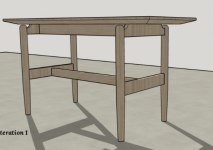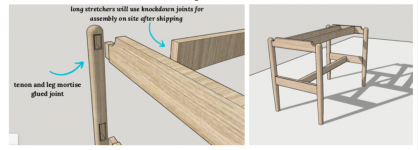Hi Guys,
I wondered of I could i could pick your brains on this. I am building a table that needs to be transported and therefore packed down as flat as possible. below is the rough design.
for construction I will make two sub assemblys consisting of two stretchers glued into their corrosponding mortises. I now need a solution where the three rails connecting and supporting the top can be connected and detached for transport purposes.
The rails between the legs are 25mm thick and the stretchers will be from 25 to 30mm thick. my idea as I have a domino 500 would be to purchase and use the knockdown connectors. I have no experience with these fastners would two rails up top and one on the bottom all conencted via 500 connectors below be provide sufficient strengh and keep everything rigid?
in terms of the big access holes. I can atleast disguise the top ones on the inside faces of the curved strechers where they wont be seen.
many thanks for any advice you have.
I wondered of I could i could pick your brains on this. I am building a table that needs to be transported and therefore packed down as flat as possible. below is the rough design.
for construction I will make two sub assemblys consisting of two stretchers glued into their corrosponding mortises. I now need a solution where the three rails connecting and supporting the top can be connected and detached for transport purposes.
The rails between the legs are 25mm thick and the stretchers will be from 25 to 30mm thick. my idea as I have a domino 500 would be to purchase and use the knockdown connectors. I have no experience with these fastners would two rails up top and one on the bottom all conencted via 500 connectors below be provide sufficient strengh and keep everything rigid?
in terms of the big access holes. I can atleast disguise the top ones on the inside faces of the curved strechers where they wont be seen.
many thanks for any advice you have.


